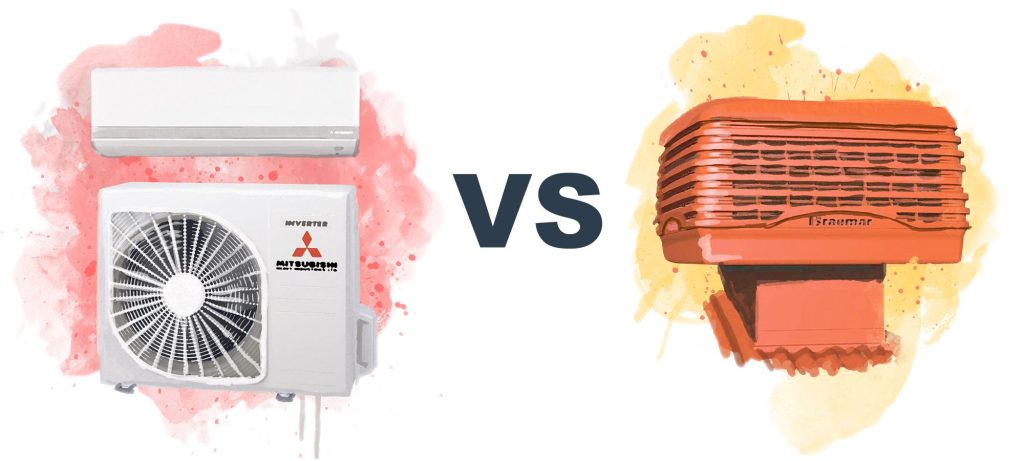Split System vs Evaporative Air Conditioning

When shopping for an air conditioner there are two main types that are installed in Australian homes, evaporative air conditioners and split system air conditioners.
Factors that should be considered when deciding between an evaporative or split system air conditioner is the size of your home, the cooling capacity of the unit, climate, installation, running and maintenance costs.
Evap air conditioning suits a specific use case and should not be directly compared to refrigeration air conditioning units in all situations.
Humidity
Humidity is the biggest factor when deciding whether evaporative air conditioning is suitable for you. If you live in a high humidity area then evaporative air conditioning isn’t an options. Evaporative air conditioning works by running water over filters and using a fan to draw air through the filters into the house evaporating the water and cooling the air. This process does not work well in areas with high humidity.

This map from the Bureau of Meteorology shows the climate and humidity across the Australia continent. If you live in any of the high humidity zones like Brisbane or Darwin then evaporative cooling will not be an option.
Evaporative cooling is most appropriate in the southern parts of Australia such as Melbourne, Adelaide and Perth and the dry inland areas like Canberra, Mildura or Alice Springs.
Cost of running the unit
The cost of running the air conditioning unit is a major consideration for most buyers when selecting a unit.
A quick example of the cost comparison between the two types of units:
With an example electricity price of $0.30 kW/hr comparing an evap and a split system running at full capacity.
5kW Split System Cost
$1.50 per hour
Evaporative Air Conditioner Cost
60 litres water per hour @ about $3.25 per kL = $0.20
Electricity usage by fan at 0.75 kWs $0.225
Total of $0.425 per hour
Cost Comparison
In this example, the evaporative cooler uses about one third the amount of electricity of the split system.
Over 100 hours this works out to a difference of $107.5 in running expenses. In a hot period, this could be as little as one week of usage.
Split System Air Conditioners
Split system air conditioners don’t work efficiently if you leave windows or doors open, so if someone in the family is a big fan of fresh air, and you’re a big fan of cool air, then split air isn’t necessarily going to be your best bet.
A standard back-to-back split system installation including wiring and appropriate permits can vary quite a bit depending on season and quality of work. You may find them cheaper but you get what you pay for. The potential exists for a poor installation to cause expensive repair costs down the track and that should be considered. A non-standard split system installation with brackets, ductwork, a long run, or additional power requirements will obviously cost more. All split system installers in all states are required to be licensed by the Australian Refrigeration Council and the person doing the wiring needs to hold a restricted electrical licence at a minimum.
Pros
- Split systems will work in any climate and if you live in a humid climate they will be the best option
- Buying a split system can be more affordable because you can add additional units to some systems or install additional units as your budget allows
- In this case, repair costs can also potentially be lower. If one unit breaks down it can be repaired separately and the others continue working
- Replacement costs can be lower, although this is not always the case, this is very dependent on the individual installation
Cons
- The cost of running a split system unit is generally a lot higher than an evaporative equivalent
- The compressor unit must be located outside of the home and this can attract from the appearance if the compressor has to be located in an obvious position. Although compressors can often be concealed or located out of the way.
- Split system air conditioners are most effective at cooling the room where the head unit is located. On hotter days multi-head units or multiple split system units will be required to cool the entire home.
Multi-head splits
Multi-head split system units have one single condenser and multiple heads inside the home. A multi-head unit is an option for cooling multiple rooms with refrigerated air conditioning.
They are the best option for whole house cooling where you can’t run ductwork, for example, a slab floor with a flat or cathedral roof.
Evaporative Air Conditioners
For an evaporative air conditioner to be most effective they require windows or doors to be open to allow airflow. As a guide, the entire volume of the room should flow through every two minutes (or around 30 air changes per hour).
During winter, older ducted units on the roof should have covers placed over them and ceiling vents closed to stop heat loss. Most new units have an automatic spring or gravitational shutter.
Pros
- Evaporative air conditioning can cost less to install in some circumstances, this really depends on the building
- Extremely cost-effective air conditioning
- Allows you to vent heat from the house if it cools down outside by drawing in cool ambient air.
- Supplies constant flow of cool air throughout the house
Cons
- Increases humidity in the house
- They are less effective when humidity is high outside
- Generally require slightly more maintenance than air conditioning
- Consider carefully before purchasing in water restricted areas or where dependant on limited water as water consumption can be up to 80 litres per hour.
References
